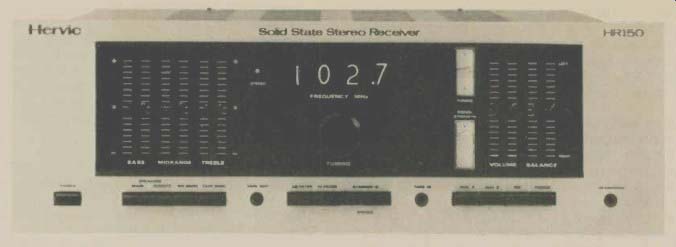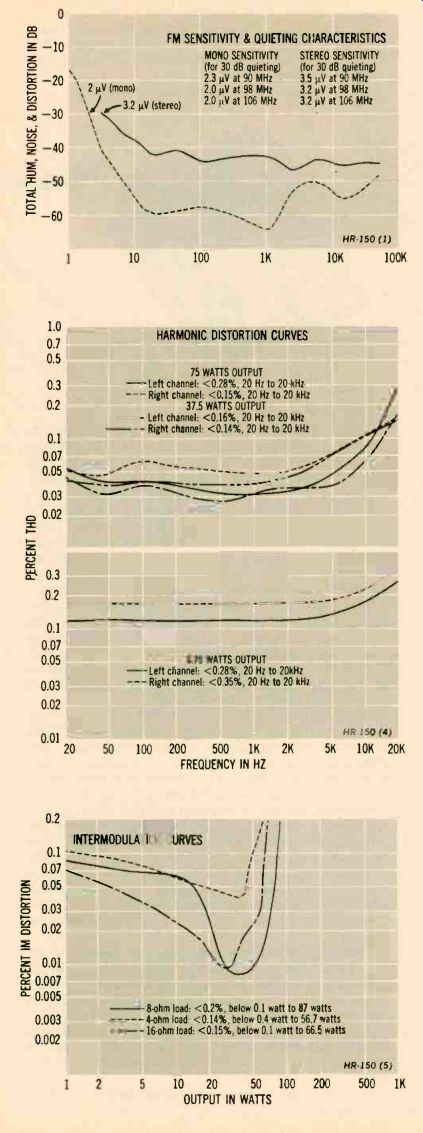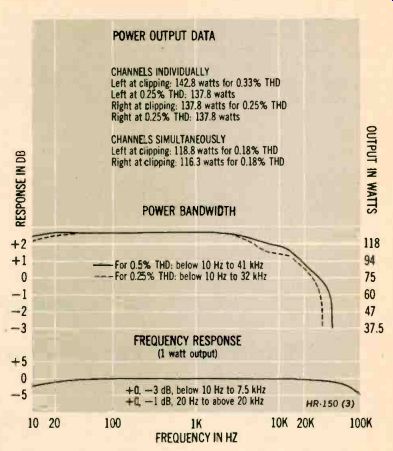
Hervic's First Stereo Receiver
The Equipment: Hervic Model HR-150, a stereo FM receiver with digital tuning display, in metal case. Dimensions: 18 by 5.25 inches (front panel); 15.25 inches deep plus allowance for controls and connections. Price: $850; optional wood case, $39.95. Warranty: three years parts (except "nixie" digital-readout tubes, for which warranty period is one year) and labor, shipping paid one way. Manufacturer: Hervic Electronics, Inc., Los Angeles, Calif. 90025.
Comment: Hervic basically is an importer (of Connoisseur turntables, Stellavox tape decks, and some other lines) but has added this receiver, built in the U.S.--actually made by SAE, we understand, though it is available only through Hervic. It is an impressive looking beast, and its performance is very fine in many ways.
Until you turn the unit on it looks like an integrated amp. At the left of the dark-glass portion of the front panel are bass, midrange, and treble sliders; at its right are volume and balance sliders. Below the glass portion are push-push switches for AC power, main speakers, remote speakers, FM muting defeat, tape monitor, high and low filters, and mono (separate buttons for each channel that deliver left-plus-right mono when both are pushed). Then come interconnected selector buttons for aux 1, aux 2, FM, and phono.
When you turn on the receiver-and no matter what source is selected-the "nixie" tubes of the digital tuning readout light up behind the glass, along with signal-strength and center-tuning meters next to the volume slider. The large knob just below the readout is, of course, for tuning. A red stereo indicator near the treble slider lights whenever the tuner section senses a subcarrier, even if the unit is on another source and/or the station is too weak to override the muting.
The front panel also has stereo phone jacks for headphone listening (live with any-or none-of the speakers selected), accessory tape in, and accessory tape out.
This tape output parallels that on the back panel, so that recordings can be made on two decks simultaneously.
The front-panel tape input, however, overrides that on the back panel; if both inputs are used, you will hear the output of the deck connected to the front panel and must remove its plug to hear that connected to the back.
This wiring is not designed with tape dubbing in mind.
For inveterate recordists with two decks the system may prove a little cumbersome. Otherwise the controls generally are a joy to use (though we judged the low filter on our test sample to produce excessive switching transients-loud enough to be annoying but not enough to endanger speakers). The tuning is silky. So is the action of the sliders, which have detents for the "normal" positions where appropriate. Pushbutton switch action is not as quiet as it might be, though the feel and spacing of these controls are excellent. The unit is very handsome indeed.
It also performed handsomely in most respects, both on the test bench and in the listening room. Its output is rated at a whopping 75 watts per channel--not really super-amp territory, but hefty for a receiver. And the distortion measurements suggest super-amps rather than receivers. The Hervic harmonic-distortion spec for the amp section is 0.25%, and all the full-output measurements are well below even this low figure except at the extreme top of the frequency range, where, in the left channel only, the 20-kHz measurement (with both channels driven) exceeds spec by a negligible 0.03%.
Note that the amp actually will produce more than the rated 75 watts. With both channels driven the clipping point is over 100 watts per channel, while the power bandwidth indicates that maximum output (measured with only one driven) is in the region of 140 watts over most of the frequency range.

------ Square-wave response


------FM SENSITIVITY & QUIETING CHARACTERISTICS
------HARMONIC DISTORTION CURVES
------INTERMODULATION CURVES
------ POWER OUTPUT DATA
------ Hervic HR-150 Additional Data

The tuner section figures also confirm or surpass most of Hervic's specs (which we assume to represent mono performance unless otherwise specified). The exceptions, in our test sample, are capture ratio (the lab got 3 dB instead of 2), selectivity (91 dB instead of 100), and high-frequency stereo separation (a little shy of the specified 30 dB at 10 kHz). None of these strike us as important. Stereo sensitivity is top-notch at 3.2 microvolts, but stereo quieting is not. The distortion measurements for stereo, though they are not really poor, are markedly inferior to those for mono and presumably contribute to the unspectacular stereo quieting curve, which nowhere reaches the 50-dB mark that we consider par for really fine tuners. In this area the tuner is not up to the standards set by the rest of the design.
And, to repeat, those standards are high. All response curves, including those for FM and phono, are unusually flat. Distortion is exceptionally low and power exceptionally high. There is that important (though unmeasurable) sense of luxury about the styling particularly the digital readout. This evidently is a receiver designed for those who like the attributes of separate tuners and amps but would like to have them in a single unit. If that is the intent, the HR-150 largely succeeds in its aims.
-------------
(High Fidelity, Apr. 1975)
Also see:
Dynaco's Super Amplifier Kit (review, Apr. 1975)